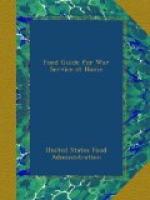Russia and Roumania were the great wheat-bins of Europe. They produced as much wheat as the United States, and sometimes more, and they were always able to make up or nearly make up the deficiencies of western Europe. Russia and Roumania are now themselves on the verge of famine. Even before their own situation became so desperate, they could get little wheat to the western Allies, because the enemy territory and the battle-lines made a great wall of separation.
Australia and India both continue to grow large crops of wheat, and have a surplus in storage, but it cannot be sent to Europe because of lack of ships. Australia has wheat stored from her last three crops. The Argentine had very poor crops in 1916 and 1917, and although the 1918 crop is good, it is scarcely more available to Europe than Australia’s wheat.
So the wheat scarcity is not A question only of the amount of wheat in the world. It is A problem of getting it where it is needed—wheat plus ships. Not a single ship must go farther than is absolutely necessary. A glance at the map shows why wheat for Europe should come from North America rather than from Australia or India, or even the Argentine. The trip from Australia is three times as long as from North America, so it takes only one-third as many ships to carry food to Europe from the United States as from Australia. The Argentine is twice as far from Europe as the United States, and therefore twice as many ships are needed to carry an equal amount of Argentine food to Europe. If this continent could produce and save enough next year to provide the whole of the Allied food necessities, we could save 1,500,000 tons of world shipping to be used for other purposes. Every ship saved is A ship built to carry more men and more ammunition to France.
WHEAT IN THE UNITED STATES
The United States has never had a large wheat surplus to export, and the last few years it has had an unusually low supply to meet the extraordinary demand. The 1916 crop was small. The 1917 crop was only four-fifths of normal, little more than we ordinarily consume ourselves. We entered the last harvest with our stocks of wheat and other cereals practically exhausted. Hence to feed the Allies until the 1918 harvest, we had to send wheat which we should ordinarily have eaten. All that we could send under normal conditions from July, 1917, to July, 1918, has usually been estimated at about 20,000,000 bushels, but in the first eleven months of this time we actually did send 120,000,000 bushels, six times as much as we could have shipped without conservation. One-half of the total output of our flour-mills in the month of May, 1918, went abroad.




